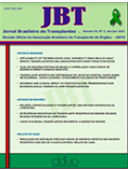Effective donation rates in Brazil and correlation with the municipal human development index
DOI:
https://doi.org/10.53855/bjt.v24i2.13Keywords:
Tissue and Organ Procurement, Transplant, Epidemiology, Public Health, Development IndicatorsAbstract
Introduction: The National Transplant System is inserted in the SUS, reflecting regional inequalities. The relationship between the municipal human development index (MHDI) and organ donation is unknown. Purpose: To analyze MHDI with effective organ donors in 2019. Methods. Analysis of the Transplant Coordination Center database in Paraná, and the Brazilian Registry of Transplants of the year 2019. Results: The mean MHDI is 0.749 + 0.04. The effective donation average was 13.01+12.21 per million population (pmp). States considered as having average MHDI (14.81%) had an effective donation average of 2.45+1.64 / pmp; high MHDI (74.07%) 12.71+10.58 and very high MHDI (11.11%) 29.13+16.06, with significant difference between groups (p 0.01). Negative linear correlation is observed in states of medium and very high MHDI, positive in states of high MHDI. The number of effective donations/pmp has grown 418% in the transition from medium to high MHDI range and 129% in the transition from high to very high MHDI. Within MHDI subgroups. there is a significant difference in the rates of effective donors/pmp between states (p 0,000), denoting the existence of other factors influencing the donation rates. Santa Catarina and Paraná stand out in the state management of the system. Conclusion: MHDI is related to the rates of effective organ donors/pmp, however it is not its main determining factor.









